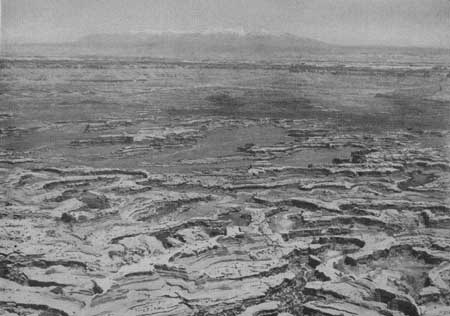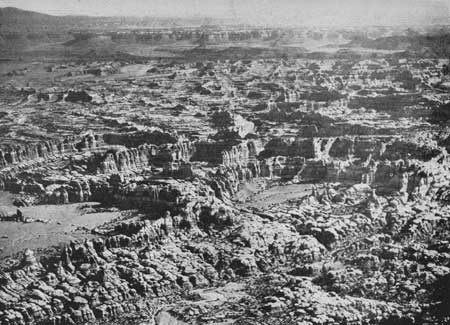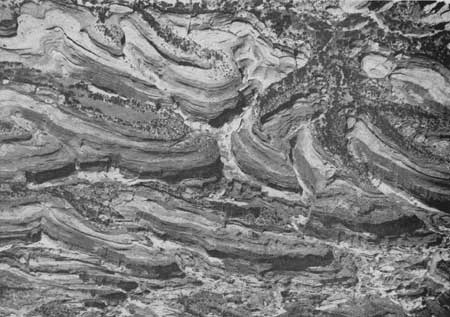.gif)
A Survey of the Recreational Resources of the Colorado River Basin
MENU
Recreational Benefits of Reservoirs
![]() Canyon Lands of Southeastern Utah
Canyon Lands of Southeastern Utah
Conservation of Recreational Resources
|
A Survey of the Recreational Resources of the Colorado River Basin
|

|
Chapter VIII:
CANYON LANDS OF SOUTHEASTERN UTAH (continued)
OUTSTANDING AND UNIQUE SCENIC
SECTIONS (continued)
Needles area.—North of Elk Ridge lies the Indian Creek country which revolves around North Six Shooter, a great monolithic guide post. West of North Six Shooter and southeast of the junction of the Colorado and the Green Rivers is a fantastic section of curiously eroded and faulted red, buff, and white rocks called the Needles. On the ground it is a seemingly endless labyrinth of little valleys above which tower great sandstone domes and pinnacles. From the air it is an amazingly intricate pattern of green, yellow, buff, pink, and red.
On August 23, 1859, Dr. J. S. Newberry, geologist to the MacComb Expedition, wrote the following description of this area as seen from the top of a butte located about a mile south of the mouth of Indian Creek:
The great canon (Grand Canyon) of the lower Colorado, with its cliffs a mile in height, affords grander and more impressive scenes, but those having far less variety and beauty of detail than this. From the pinnacle on which we stood the eye swept over an area some fifty miles in diameter, everywhere marked by features of more than ordinary interest; lofty lines of massive mesas rising in successive steps to form the frame of the picture; the interval between them more than 2,000 feet below their summits. A great basin of sunken plain lay stretched out before us as on a map. Not a particle of vegetation was anywhere discernible; nothing but bare and barren rocks of rich and varied colors shimmering in the sunlight. Scattered over the plain were thousands of the fantastically formed buttes to which I have so often referred in my notes; pyramids, domes, towers, columns, spires, of every conceivable form and size. Among these by far the most remarkable was the forest of Gothic spires, first and imperfectly seen as we issued from the mouth of the Canon Colorado. Nothing I can say will give an adequate idea of the singular and surprising appearance which they presented from this new and advantageous point of view. Singly, or in groups, they extend like a belt of timber for a distance of several miles. Nothing in nature or in art offers a parallel to these singular objects, but some idea of their appearance may be gained by imagining the island of New York thickly set with spires like that of Trinity Church, but many of them full twice in height. Scarcely less striking features in the landscape were the innumerable canons by which the plain is cut. In every direction they ran ramified deep, dark, and rugged, impassable to everything but the winged bird. Of these the most stupendous was that of Grand River, which washes two sides of the base of the pinnacle on which we stood, a narrow chasm, as we estimated, full 1,500 feet in depth, into which the sun scarcely seemed to penetrate. At the bottom the whole breadth of this canon is occupied by the turbid waters of Grand River, here a sluggish stream, at least with no current visible to us who were more than 2,000 feet above it. In this great artery a thousand lateral tributaries terminate, flowing through channels precisely like that of Labyrinth Creek; underground passes by which intermittent floods from the distant highlands are conducted through this country, producing upon it no other effect than constantly to deepen their own beds.

|
| Figure 92.—The approach to the Needles labyrinth is from Indian Creek. La Sal Mountains are in the distance. (Air photo) |

|
| Figure 93.—The Needles area—looking northeast over Indian Creek Valley. (Air photo) |

|
| Figure 94.—The Needles area from the air is an intricate pattern of green, yellow, buff, pink, and red. |

|
| Figure 95.—The Needles area is carved out of Cutler sandstone. |
NEXT >>>
Last Modified: Mon, Sep 6 2004 10:00:00 pm PDT
http://www.cr.nps.gov/history/online_books/colorado/chap8c.htm
![]()
 Top
Top